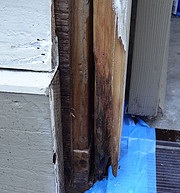Developing a Projected Cost Budget

It is not surprising to know that in the initial phases of every proposed construction project, it is the first task of the Construction Manager (CM), along with other trained professionals such as the Architect and Engineer of record, to develop projected cost budgets. These are the anticipated costs the project will generate, including such items as labor, material and equipment expenses. Obviously, without such cost estimates, a homeowner association board would have no significant way of knowing if they have the resources to fund the project adequately.
In order to develop the most accurate cost estimates possible, the CM will utilize a two step approach; first a constructibility/feasibility review and, second, the bidding process.
Constructibility and Feasibility Review
In the constructibility/feasibility review, the CM, utilizing “industry average” values for most expense items, develops generic costs for the project. These costs, set as a benchmark, are provided to the HOA to determine initially whether the scope of work, as first contemplated, is within their financial means. If so, then the CM will proceed with the bidding process to generate concrete, or hard, costs from the contractors vying for award of the project. If not, then the CM would have to “Value Engineer”, or reassess the scope of work, materials and methods of the project in order to reduce the projected costs and bring the project scope of work into an area that the HOA can afford.
Bidding Phase
Building on the estimated costs of the constructibility/feasibility review, in the bidding phase, the CM will attempt to enhance the cost projections by putting the final project scope of work out to bid. To ensure that the costs provided by the bidding contractors are relatively accurate, the CM will develop specifications for the project that define, with great detail, what scope of work will be performed, in what manner, and with what acceptable materials. Each prospective contractor bidding on the project will have an opportunity to review the specifications, perform an onsite evaluation walkthrough, and generate their own estimated costs to perform the construction according to the specification’s guidelines. The selected bid will later become the fee structure of the contractor awarded the project.

In both the constructability review and bidding phases, there is always one aspect of the cost calculation process that can give rise to confusion on the part of the HOA—the “Unforeseen Conditions” line item. Industry-wide, this is the flat ten to fifteen percent charge added to the end value of every bid and constructibility review/feasibility study figure. The comments from the board vary in tone, but all seem to highlight one general theme: Why should we budget a blank check line item for the contractor when we pay you to develop accurate and complete specifications and cost projections?
The answer is simple—there is no such thing as an accurate and complete cost projection.
Six Unpredictable Conditions that Raise Total Cost
There are a variety of unforeseen conditions that can impact the total cost of a project negatively. Here are several:
Jurisdictional Fees and Prerequisites
Most of the Bay area’s local building departments, those infamous governmental agencies that approve construction projects and issue permits, have steadily, and stealthily, increased their permit costs. Unfortunately, uniformity in building department permit fees is not the norm. For example, in a review of 15 bay area building departments conducted recently, all had raised their rates significantly from recent years, and most had new or revised approval prerequisites. Prerequisites ranged from the number of visits by an inspector necessary to issue a Certificate of Occupancy upon completion of the project, to what tools had to be on hand when the inspector arrived in order to facilitate the inspection. Not suprisingly, when questioned individually, different personnel in the same building department had different prerequisites for identical construction projects. Such confusion and increased costs have lead to an unforeseen condition of time and fee expenses that cannot be measured accurately by contractors or consultants.

Example of dry rot damage to a door frame
Decay and Dry Rot
Both the constructibility/feasibility review and bidding documentation discussed in this article base their projected costs on a visual inspection and review of existing conditions. Obviously, with few exceptions, there is no way for the CM or the bidding contractor to know what lies within building cavities when they develop the original cost projections. Only when these areas are opened up does the true nature and extent of decay or mold come to light. Consequently, it is not surprising to have a contractor submit change orders subsequent to initial demolition, once the first building tear off has begun. Significant decay leads to significant additional costs. By contractor’s state law it is the responsibility of the contractor to remove and replace such decayed material, and it is the responsibility of the HOA to pay for it.
Existing Conditions
Like decay, existing building conditions also may not be identifiable until the building structure is open. No one knows if the original construction was built according to the plans and blueprints, building code, and/or standards of workmanship applicable at that time. Notwithstanding, the repair methods developed in the current specifications, which the potential contractors use in establishing their bids, assume that all the existing construction was built according to the plans and the code that was in effect at the time of original construction. Consequently, if there was a deviation from the code, the condition would need to be remedied as an unforeseen condition.
Granted, in cases of reconstruction instigated by litigation, repair schedules developed by experts in the field of forensic testing could mitigate the unforeseen condition, but those schedules do not evaluate every unit in every building for the same condition. The forensic evaluations perform “statistical sampling” of a random number of locations (traditionally 10 percent of an HOA complex). Thus, there is usually no possible way of realizing exactly how many locations throughout the project have an existing condition that fails to meet building codes, until each and every location has been opened.
Hazardous Materials
Some older multi-unit residential construction projects may be infested with hazardous materials, most notably asbestos, lead paint or molds/fungus. Under traditional circumstances, these conditions may not affect the construction project and thus are not traditionally included in the original cost projections. For example, if the asbestos were in the ceilings of the units whose roofs are currently being re-roofed, then the only impact on the project would occur should a roofer fall through the roof and damage the ceiling. Understandably, there is no way to estimate how many times a roofer’s employees would fall through roofs throughout the life of the project! On the other hand, should the asbestos be in the existing roofing material, which the contractor would be removing, and replacing, then the initial budgets should include the remediation cost of removal and disposal of the asbestos.
Homeowner Scheduling
It is difficult for the CM to know the attitude of individual homeowners toward the work being proposed. Depending on the HOA membership, access issues generate many additional hours for the CM and contractor. When unit owners fail to allow access to their units for construction personnel to work or when unit owners fail to follow post construction policies such as limited usage of certain areas of the unit where material is not dry, the costs mount quickly.
To mitigate project expense, the CM, HOA board and contractor meet at the inception of each project to develop a schedule for construction, identifying which buildings will be worked on in a particular order to maximize efficiency during the life of the project. Equipment trailers are parked at one location and employees are dispersed based on the schedule.
Preliminary notices are distributed to designated units and buildings, by both the CM and contractor several weeks before the work commences. The notices state what work will be commenced at each unit, the commencement day, and the term period of construction at each unit. The notices further state that it is the responsibility of the homeowners to have their units ready for construction (either interior or exterior work), including having all furniture moved to a safe and secure distance away from the construction area, having all valuable items removed and stored in a secure location, and having all pets confined.
If the contractor fails to find the unit in such a prepared condition, delays occur because the work at that unit must be rescheduled and the construction schedule revised. Likewise, when certain unit owners fail to allow access because they disagree with the HOA’s ultimate construction goals, or they fail to divulge prior vacation or other long absentee periods during the project period, the contractor is forced to revise the project schedule. Remobilization of the crew and equipment trailers to other locations on a weekly, if not daily basis, leads to change orders and additional costs.
Damaged Items
At the termination of the project, some unit owners may file expense reimbursement charges with the association for personal items that were damaged as a result of the construction. While the contractor, based on his liability for their damage, reimburses some items, many items are not, and are thus left for the HOA to determine ultimate liability and compensate members. Obviously, most contractors will not reimburse for items that were the responsibility of the unit owner to store, secure or remove from the premises prior to construction that are subsequently damaged or destroyed. Resolution of such claims adds both time and money to the project budget.
The above list is not exhaustive. While many hours are spent in the pre-construction phase to develop accurate cost representations, it is impossible to determine all variable costs that will impact the bottom line. In this regard, construction is more an art than a science, and contingency costs for “Unforeseen Conditions” are a necessary evil that must exist in order to allow an HOA to fund needed projects adequately. Without such a contingency, the greatest delay possible—the inability of the HOA to adequately finance the project from inception to completion—would occur regularly, forcing suspension of work.
Ken Kosloff is Prinicipal at Richard Avelar Associates and a member of the ECHO Maintenance Resource Panel. Photo courtesy of David Schott.